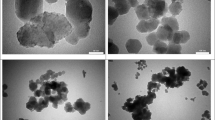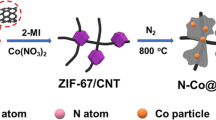Abstract
In this work, a facile method is reported for the synthesis of ZIF-67-derived cobalt and nitrogen-doped carbon (Co-N-C) materials with enlarged average pore sizes as electrocatalysts towards oxygen reduction reaction (ORR). The pore diameters of the Co-N-C can be greatly enlarged using NaCl as an additive during the pyrolyzing process. Thermo-gravimetry (TG) results suggest that NaCl could facilitate the structural decomposition of ZIF-67, resulting in the adjusted physiochemical properties of the obtained Co-N-C materials. The CoNC-1NaCl-700 and CoNC-1NaCl-800 materials derived from ZIF-67 in the presence of NaCl at relatively high pyrolyzing temperatures (i.e., 700 °C, 800 °C) exhibit superior catalytic activity compared with the CoNC materials derived from pure ZIF-67, which could be due to their unique structures of larger average pore sizes, higher surface areas, higher contents of pyridinic-N and graphitic-N. The onset potential of the CoNC-1NaCl-800 towards ORR is 0.94 V (vs. RHE) and the half-wave potential is 0.84 V (vs. RHE), which are comparable with that of commercial Pt/C.







Similar content being viewed by others
References
Wu D, Shen X, Pan Y, Yao L, Peng Z (2020) Platinum alloy catalysts for oxygen reduction: advances, challenges and perspectives. ChemNanoMat 6:32–41
Shi Q, Liu Q, Ma Y, Fang Z, Liang Z, Shao G, Tang B, Yang W, Qin L, Fang X (2020) High-performance trifunctional electrocatalysts based on FeCo/Co2P hybrid nanoparticles for zinc-air battery and self-powered overall water splitting. Adv Energy Mater 10:1903854
Li Y, Liu Y, Qian Q, Wang G, Zhang G (2020) Supramolecular assisted one-pot synthesis of donut-shaped CoP@PNC hybrid nanostructures as multifunctional electrocatalysts for rechargeable Zn-air batteries and self-powered hydrogen production. Energy Storage Mater 28:27–36
Cai J, Zhou Q, Liu B, Gong X, Zhang Y, Goh K, Gu D, Zhao L, Sui X, Wang Z (2020) A sponge-templated sandwich-like cobalt-embedded nitrogen-doped carbon polyhedron/graphene composite as a highly efficient catalyst for Zn-air batteries. Nanoscale 12:973–982
Zhou Q, Zhang Z, Cai J, Liu B, Zhang Y, Gong X, Sui X, Yu A, Zhao L, Wang Z, Chen Z (2020) Templated-guided synthesis of Co nanoparticles embedded in hollow nitrogen doped carbon tubes as a highly efficient catalyst for rechargeable Zn-air batteries. Nano Energy 71:104592
Nie Y, Wei Z (2015) Recent advancements in Pt and Pt free catalysts for oxygen reduction reaction. Chem Soc Rev 44:2168–2201
Li Q, Wu L, Wu G, Su D, Lv H, Zhu W, Casimir A, Zhu H, Mendoza-Garcia A, Sun S (2015) New approach to fully ordered fct-FePt nanoparticles for much enhanced electrocatalysis in acid. Nano Lett 15:2468–2473
Wu G, Santandreu A, Kellogg W, Gupta S, Ogoke O, Zhang H, Wang H, Dai L (2016) Carbon nanocomposite catalysts for oxygen reduction and evolution reactions: from nitrogen doping to transition-metal addition. Nano Energy 29:83–110
Wang J, Li S, Zhu G, Zhao W, Chen R, Pan M (2013) Novel non-noble metal electrocatalysts synthesized by heat-treatment of iron terpyridine complexes for the oxygen reduction reaction. J Power Sources 240:381–389
Wu G, More K, Johnston C, Zelenay P (2011) High performance electrocatalysts for oxygen reduction derived from polyaniline, iron, and cobalt. Science 332:443–447
Yoon M, Srirambalaji R, Kim K (2012) Homochiral metal-organic frameworks for asymmetric heterogeneous catalysis. Chem Rev 112:1196–1231
Tranchemontagne DJ, Park KS, Furukawa H, Eckert J, Knobler CB, Yaghi OM (2012) Hydrogen storage in new metal-organic frameworks. J Phys Chem C 116:13143–13151
Zeng H, Xie X, Xie M, Huang Y, Luo D, Wang T, Zhao Y, Lu WG, Li D (2019) Cage-interconnected metal-organic framework with tailored apertures for efficient C2H6/C2H4 separation under humid conditions. J Am Chem Soc 51:20390–20396
Zeng T, Wang L, Feng L, Xu H, Cheng Q, Pan Z (2019) Two novel organic phosphorous-based MOFs: synthesis, characterization and photocatalytic properties. Dalton Trans 48:523–534
He Y, Hou X, Liu Y, Feng N (2019) Recent progress in the synthesis, structural diversity and emerging applications of cyclodextrin-based metal-organic frameworks. J Mater Chem B 7:5602–5619
Ma S, Goenaga G, Call A, Liu D (2011) Cobalt imidazolate framework as precursor for oxygen reduction reaction electrocatalysts. Chem-Eur J 17:2063–2067
Afsahi F, Kaliaguine S (2014) Non-precious electrocatalysts synthesized from metal-organic frameworks. J Mater Chem A 2:12270–12279
Chen X, Shen K, Chen J, Huang B, Ding D, Zhang L, Li Y (2017) Rational design of hollow N/Co-doped carbon spheres from bimetal-ZIFs for high-efficiency electrocatalysis. Chem Eng J 330:736–745
You B, Jiang N, Sheng M, Drisdell W, Yano J, Sun Y (2015) Bimetal-organic framework self-adjusted synthesis of support-free nonprecious electrocatalysts for efficient oxygen reduction. ACS Catal 5:7068–7076
Wang X, Zhou J, Fu H, Li W, Fan X, Xin G, Zheng J, Li X (2014) MOF derived catalysts for electrochemical oxygen reduction. J Mate Chem A 2:14064–14070
Li Z, Shao M, Zhou L, Zhang R, Zhang C, Wei M, Evans D, Duan X (2016) Directed growth of metal-organic frameworks and their derived carbon-based network for efficient electrocatalytic oxygen reduction. Adv Mater 28:2337–2344
Palaniselvam T, Biswal B, Banerjee R, Kurungot S (2013) Zeolitic imidazolate framework (ZIF)-derived, hollow-core, nitrogen-doped carbon nanotubes for oxygen reduction reactions in PEFCs. Chem-Eur J 19:9335–9342
Zhu Q, Xia W, Akita T, Zou R, Xu Q (2016) Metal-organic framework-derived honeycomb-like open porous nanostructures as precious-metal-free catalysts for highly efficient oxygen electroreduction. Adv Mater 28:6391–6398
Dou S, Li X, Tao L, Huo J, Wang S (2016) Cobalt nanoparticle-embedded carbon nanotube/porous carbon hybrid derived from MOF-encapsulated Co3O4 for oxygen electrocatalysis. Chem Commun 52:9727–9730
Ma X, Zhao X, Huang J, Sun L, Li Q, Yang X (2017) Fine Co nanoparticle encapsulated in a N-doped porous carbon matrix with superficial N-doped porous carbon nanofibers for efficient oxygen reduction. ACS Appl Mater Inter 9:21747–21755
Li X, Jiang Q, Dou S, Deng L, Huo J, Wang S (2016) ZIF-67-derived Co-NC@CoP-NC nanopolyhedra as an efficient bifunctional oxygen electrocatalyst. J Mater Chem A 4:15836–15840
Zhang E, Xie Y, Ci S, Jia J, Cai P, Yi L, Wen Z (2016) Multifunctional high-activity and robust electrocatalyst derived from metal-organic frameworks. J Mater Chem A 4:17288–17298
Hu Z, Zhang Z, Li Z, Dou M, Wang F (2017) One-step conversion from core-shell metal-organic framework materials to cobalt and nitrogen co-doped carbon nanopolyhedra with hierarchically porous structure for highly efficient oxygen reduction. ACS Appl Mater Inter 9:16109–16116
Zhao R, Xia W, Lin C, Sun J, Mahmood A, Wang Q, Qiu B, Tabassun H, Zou R (2017) A pore-expansion strategy to synthesize hierarchically porous carbon derived from metal-organic framework for enhanced oxygen reduction. Carbon 114:284–290
Song X, Guo L, Liao X, Liu J, Sun J, Li X (2017) Hollow carbon nanopolyhedra for enhanced electrocatalysis via confined hierarchical porosity. Small 13:1700238
Shang L, Yu H, Huang X, Bian T, Shi R, Zhao Y, Waterhouse G, Wu L, Tung C, Zhang T (2016) Well-dispersed ZIF-Derived Co, N- co-doped carbon nanoframes through mesoporous-silica-protected calcinations as efficient oxygen reduction electrocatalysts. Adv Mater 28:1668–1674
Chen L, Wang H, Shen X, Zhang Y, Duan C (2019) A novel route for generation of Co/CoZn/CoNi layered double hydroxides at ambient temperature. Inorg Chem Front 6:1415–1421
Zhou X, Gao Y, Deng S, Cheng S, Zhang S, Hu H, Zhuang G, Zhong X, Wang J (2017) Improved oxygen reduction reaction performance of Co confined in ordered N-doped porous carbon derived from ZIF-67@PILs. Ind Eng Chem Res 56:11100–11110
Wang Z, Ang J, Zhang B, Zhang Y, Ma XYD, Yan T, Liu J, Che B, Huang Y, Lu X (2019) FeCo/FeCoNi/N-doped carbon nanotubes grafted polyhedron-derived hybrid fibers as bifunctional oxygen electrocatalysts for durable rechargeable zinc-air battery. Appl Catal B-Environ 254:26–36
Ai K, Li Z, Cui X (2017) Scalable preparation of sized controlled Co-N-C electrocatalyst for efficient oxygen reduction reaction. J Power Sources 368:46–56
Xia B, Yan Y, Li N, Wu HB, Lou X, Wang X (2016) A metal-organic framework-derived bifunctional oxygen electrocatalyst. Nat Energy 1:15006
Li J, Du G, Cheng X, Feng P, Luo X (2018) CoNiP/NC polyhedrons derived from cobalt-based zeolitic imidazolate frameworks as an active electrocatalyst for oxygen evolution. Chinese J Catal 39:982–987
Zhou Q, Zhao L, Sui X, Gong X, Li J, Li X, Wang Z (2018) Cobalt and nitrogen codoped carbon nanosheets templated from NaCl as efficient oxygen reduction electrocatalysts. Chem Asian J 13:3057–3062
Zhao X, He X, Chen B, Yin F, Li G (2019) MOFs derived metallic cobalt-zinc oxide@nitrogen-doped carbon/carbon nanotubes as a highly efficient electrocatalyst for oxygen reduction reaction. Appl Surf Sci 487:1049–1057
Feng W, Wang Y, Chen J, Li B, Guo L, Ouyang J, Jia D, Zhou Y (2018) Metal organic framework-derived CoZn alloy/N-doped porous carbon nanocomposites: tunable surface area and electromagnetic wave absorption properties. J Mater Chem C 6:10–18
Liu C, Wang LJ, Liu J, Wang SX, Shen J, Han W, Wang L (2017) Electrospun ZIF-based hierarchical carbon fiber as an efficient electrocatalyst for the oxygen reduction reaction. J Mater Chem A 5:1211–1220
Li L, Dai P, Gu X, Wang Y, Yan L, Zhao X (2017) High oxygen reduction activity on a metal organic framework derived carbon combined with high degree of graphitization and pyridinic-N dopants. J Mater Chem A 5:789–795
Shu J, Niu Q, Wang N, Nie J, Ma G (2019) Alginate derived Co/N doped hierarchical porous carbon microspheres for efficient oxygen reduction reaction. Appl Surf Sci 485:520–528
Quan L, Yu X, Wang T, Yin W, Liu J, Wang L, Zhang Y (2019) Ultrafine Co@nitrogen-doped carbon core-shell nanostructures anchored on carbon nanotubes for highly efficient oxygen reduction. Appl Surf Sci 494:691–699
Kuang M, Wang Q, Han P, Zheng G (2017) Cu, Co-embedded N-enriched mesoporous carbon for efficient oxygen reduction and hydrogen evolution reactions. Adv Energy Mater 7:1700193
Chen B, Li R, Ma G, Gou X, Zhu Y, Xia Y (2015) Cobalt sulfide/N,S codoped porous carbon core-shell nanocomposites as superior bifunctional electrocatalysts for oxygen reduction and evolution reactions. Nanoscale 7:20674–20684
Qian J, Sun F, Qin L (2012) Hydrothermal synthesis of zeolitic imidazolate framework-67 (ZIF-67) nanocrystals. Mater Lett 82:220–223
Shimada N, Kawamoto H, Saka S (2008) Different action of alkali/alkaline earth metal chlorides on cellulose pyrolysis. J Anal Appl Pyrolysis 81:80–87
Santana JA Jr, Sousa NG, Cardoso CR, Carvalho WS, Ataíde CH (2016) Sodium, zinc and magnesium chlorides as additives for soybean hulls pyrolysis Influence on the temperature range of reactions and product selectivity. J Therm Anal Calorim 125:471–481
Liang Q, Chen Z, Chen X, Li Y (2019) A KCl-assisted pyrolysis strategy to fabricate nitrogen-doped carbon nanotube hollow polyhedra for efficient bifunctional oxygen electrocatalysts. J Mater Chem A 7:20310–20316
Zhu Z, Chen C, Cai M, Cai Y, Ju H, Hu S, Zhang M (2019) Porous Co-N-C ORR catalysts of high performance synthesized with ZIF-67 templates. Mater Res Bull 114:161–169
Zhao Y, Zhang H, Zhang Y, Zhang M, Yu J, Liu H, Yu Z, Yang B, Zhu C, Xu J (2019) Leaf-like 2D nanosheet as efficient oxygen reduction reaction catalyst for Zn-air battery. J Power Sources 434:226717
Wen X, Yang X, Li M, Bai L, Guan J (2018) Co/CoOx nanoparticles inlaid onto nitrogen-doped carbon-graphene as a trifunctional electrocatalyst. Electrochim Acta 296:830–841
Guo J, Gao M, Nie J, Yin F, Ma G (2019) ZIF-67/PAN-800 bifunctional electrocatalyst derived from electrospun fibers for efficient oxygen reduction and oxygen evolution reaction. J Colloid Interf Sci 544:112–120
Funding
This work is financially supported by the National Natural Science Foundation of China (21805244, 51776188).
Author information
Authors and Affiliations
Corresponding author
Ethics declarations
Conflict of interest
The authors declare that they have no conflict of interest.
Additional information
Publisher’s note
Springer Nature remains neutral with regard to jurisdictional claims in published maps and institutional affiliations.
Rights and permissions
About this article
Cite this article
Suo, Y., Zhang, Z., Zhang, Z. et al. Cobalt and nitrogen-doped carbon with enlarged pore size derived from ZIF-67 by a NaCl-assisted pyrolysis strategy towards oxygen reduction reaction. Ionics 27, 289–303 (2021). https://doi.org/10.1007/s11581-020-03776-2
Received:
Revised:
Accepted:
Published:
Issue Date:
DOI: https://doi.org/10.1007/s11581-020-03776-2




